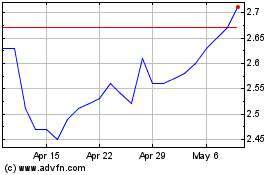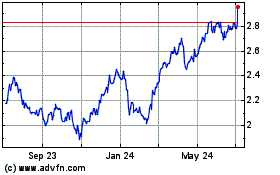Lloyds Takes Fresh PPI Charge -- Update
October 28 2015 - 5:23AM
Dow Jones News
By Margot Patrick
LONDON-- Lloyds Banking Group PLC's compensation bill for
mis-sold loan insurance rose to GBP13.9 billion ($21.3 billion) on
Wednesday after a fresh GBP500 million charge that weighed on
third-quarter profit.
The British bank said net profit was GBP690 million, down
slightly from GBP693 million a year earlier. Underlying profit,
which strips out certain costs and provisions and excludes the TSB
unit it floated last year, was down 3% at GBP1.97 billion from
GBP2.04 billion.
Shares in Lloyds fell by 4% as analysts said that the results
were worse than expected, largely because of a fall in the bank's
"other income" line that includes revenue from commercial banking,
insurance and noncore assets.
The new provision to compensate customers who were wrongfully
sold insurance on loans and credit cards was also higher than some
analysts had estimated. Lloyds has borne the brunt of a total
sector bill running at around GBP27 billion, after a 2011 court
ruling cleared the way for customer rebates.
Lloyds executives on Wednesday said they're waiting to hear
whether the Financial Conduct Authority might impose a 2018
deadline on the claims. The said they're also in "wait and see"
mode on a separate legal case that could result in a slew of new
claims on other commission-based products.
For decades PPI was sold to cover mortgage, auto and other loan
payments if the borrower lost a job or fell ill. Many people didn't
need the insurance or could actually claim on it.
The bank separately took another GBP100 million charge in the
quarter to cover potential claims on other types of products sold
through its branch network.
Chief Executive António Horta-Osório said the group has had a
good year so far, with underlying profit rising 6% in the first
nine months compared with the year earlier. He said the U.K.'s low
unemployment levels, increased house prices, higher consumer
spending and lower household debt are all providing "a positive
backdrop to the group's future prospects."
Mr. Horta-Osório has been selling assets and exiting countries
since taking over as CEO in 2011, and is now credited with having
gotten Lloyds back on solid footing after a government rescue in
the financial crisis. Once a sprawling global organization, the
bank's main focus now is lending to British households and
businesses.
Reflecting the improved health of the U.K. economy, bad loans
fell to GBP157 million in the third quarter, from GBP236 million in
the third quarter of 2014. Operating costs were down slightly, at
GBP1.92 billion from GBP1.97 billion.
The U.K. government still owns just under 11% of the bank, down
from 43% at the peak of the bailout. Ongoing share sales to
institutional investors are expected to take the stake lower still,
and more than 250,000 people have registered interest in buying
Lloyds stock in a planned retail share sale next spring, Chancellor
George Osborne said this month.
Write to Margot Patrick at margot.patrick@wsj.com
(END) Dow Jones Newswires
October 28, 2015 05:08 ET (09:08 GMT)
Copyright (c) 2015 Dow Jones & Company, Inc.
Lloyds Banking (NYSE:LYG)
Historical Stock Chart
From Mar 2024 to Apr 2024

Lloyds Banking (NYSE:LYG)
Historical Stock Chart
From Apr 2023 to Apr 2024
